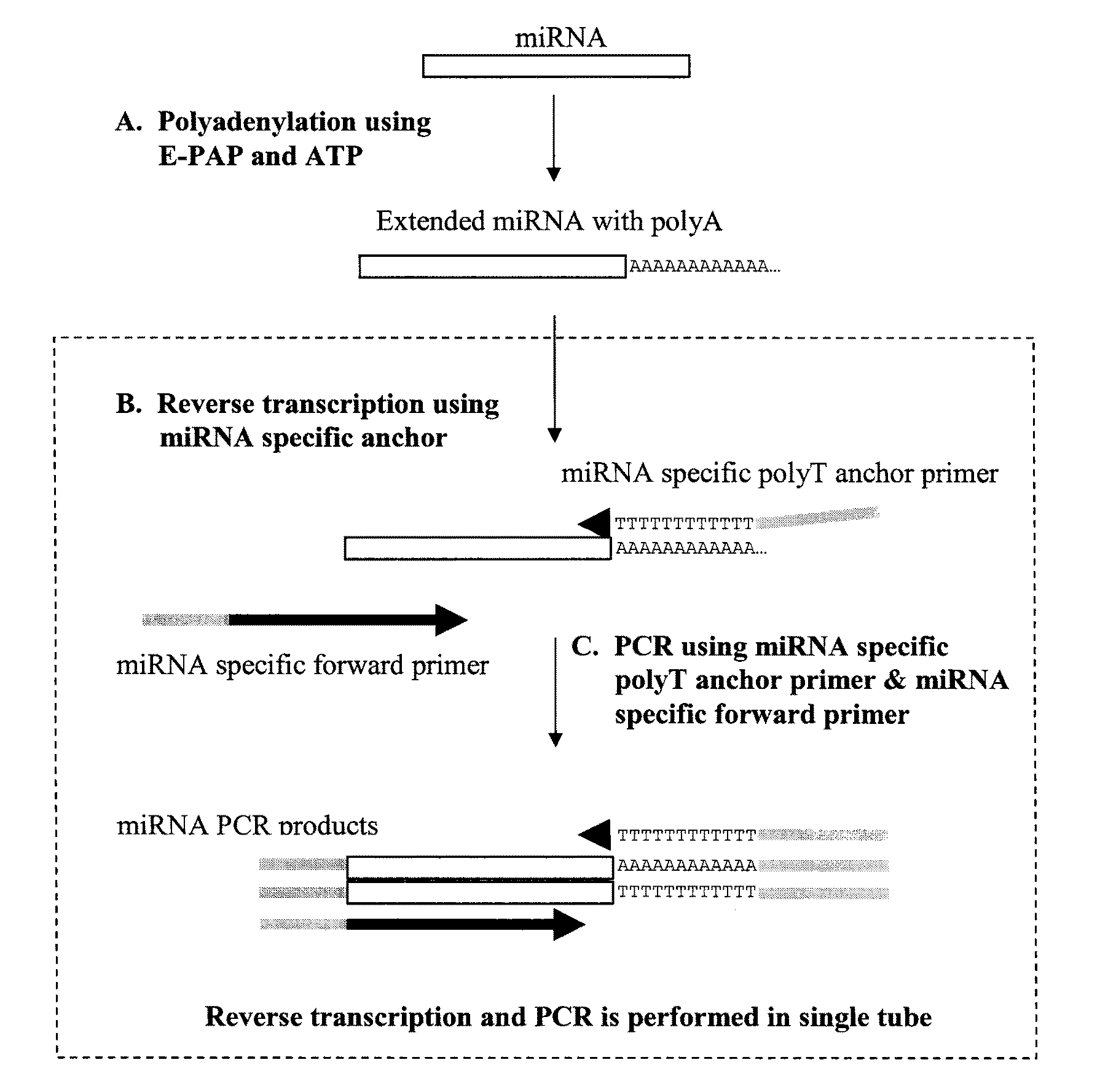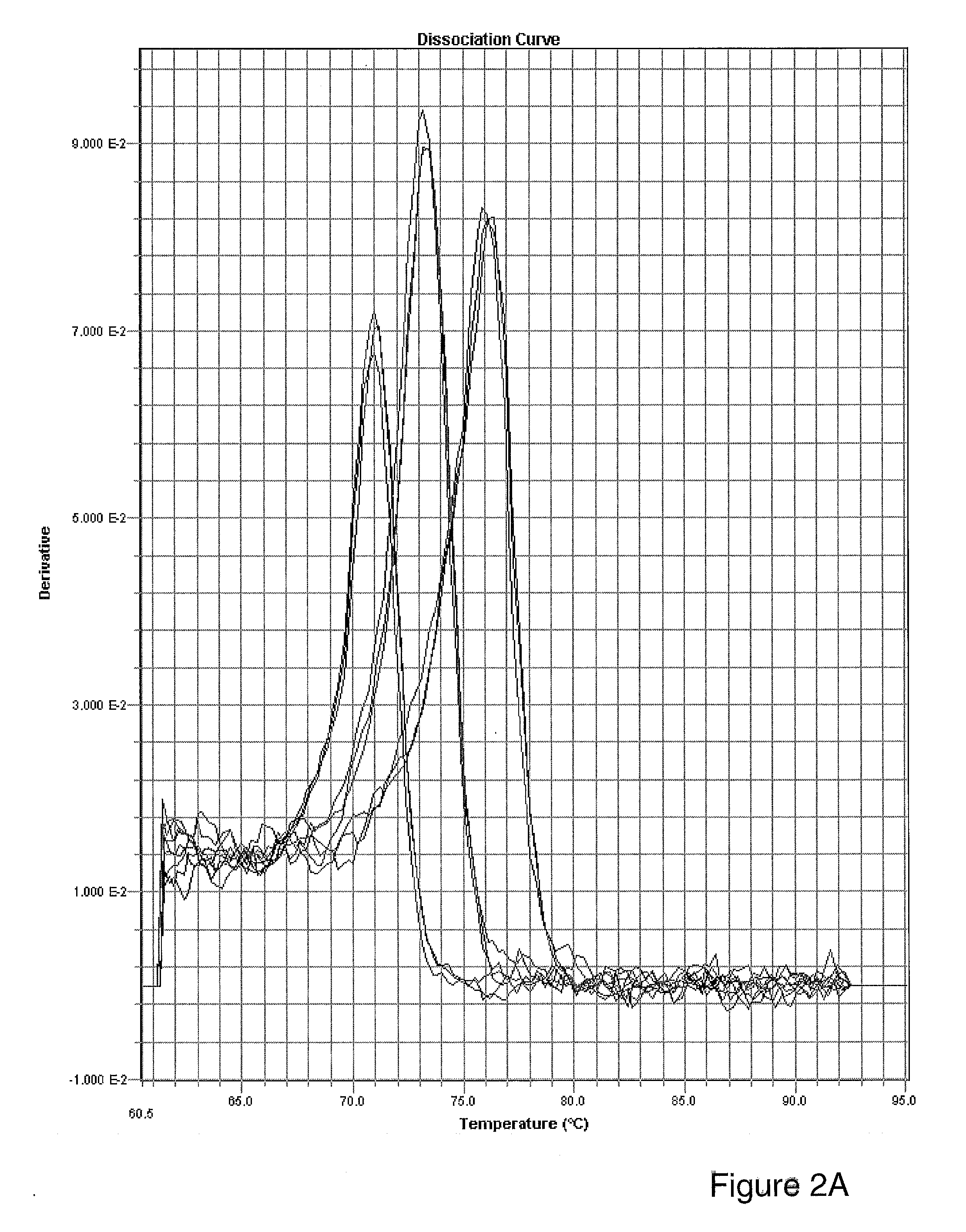Identifying and quantifying small RNAs
a technology of rnas and rnas, applied in the field of identifying and quantifying small rnas, can solve the problems of significant challenge for the small size of small rnas
- Summary
- Abstract
- Description
- Claims
- Application Information
AI Technical Summary
Benefits of technology
Problems solved by technology
Method used
Image
Examples
example 1
[0042]This example illustrates the amplification of small RNAs in one-step real time RT-PCR.
[0043]Total RNA of Human hela cells and Arabidopsis was purified by Trizol reagent (Invitrogen, Inc., Carlsbad, Calif.) according to the manufacturer's instructions. Before performing RT-PCR, total RNA of hela cells or Arabidopsis were polyadenylated by E-PAP I and ATP using RNA poly A tailed kit (Ambion, Inc., Austin, Tex.). Briefly, 1 μg total RNA was used in 20 μL reaction mixtures containing 4 μL 5×E-PAP I buffer, 2 μL of 25 mM McCl2, 2 μL of 10 mM ATP and 1 μL of E-PAP I at a concentration of 2 U / μL. Reaction mixtures were then incubated at 37° C. for 1 hour. After polyadenylation, the mixtures were diluted with RNase-free water and used as templates for RT-PCR.
[0044]The small RNAs evaluated by the present method were an miRNA from human cells and an miRNA from a plant of an Arabidopsis species and a human small non-coding RNA, small nuclear RNA U6, which is frequently used as internal r...
example 2
[0047]This example illustrates amplification efficiency, sensitivity and dynamic range of the one-step RT-PCR method for small RNAs.
[0048]Ten-fold dilution series of synthetic RNA oligonucleotides or total RNA were used as the template for real-time PCR to generate plots of log copy numbers of the tested miRNA at different dilutions versus the corresponding threshold cycle (Ct). Amplification efficiency of the real-time PCR was determined as follows. The slope of the linear plot was defined as −(1 / log E), where E is the amplification efficiency. The value for E should approach 2 as the efficiency reaches the maximum (Livak and Schmittgen, 2001, Methods 25:402-408)
[0049]In experiments using synthetic RNA oligonucleotides, 1 pmol synthetic RNA oligonucleotide of the human miRNA hsa-mir-21, was added to 1 μg Arabidopsis total RNA for polyadenylation and then diluted with RNase-free water in a series of reaction mixtures representing several orders of magnitude. The results shown in FIG...
example 3
[0051]This example illustrates the specificity of real-time RT-PCR assay for small RNAs using mismatched primers.
[0052]Assay specificity was tested by using primer sequences with mismatched nucleotides as shown in FIG. 4A. Small RNAs, in amounts corresponding to 100 pg total RNA, were used as templates for one-step real time RT-PCR with primer sets shown in FIG. 4A.
[0053]Quantification data for the different primer sets was based upon the assumption that amplification was 2 for all primer sets. Calculations were performed using the formula 2−ΔCt, where ΔCt=(Cttest primer set−Ctnormal primer set). Because PCR using the normal primer set should generate the lowest Ct value, the Ct value for the normal primer set was assumed to represent 100% and its Ct value was used for normalization in each comparison. The results show that no PCR amplification occurred using a primer with 2 mismatched nucleotides, whereas primers with 1 mismatch showed greatly reduced amplification compared to ampl...
PUM
 Login to View More
Login to View More Abstract
Description
Claims
Application Information
 Login to View More
Login to View More - R&D
- Intellectual Property
- Life Sciences
- Materials
- Tech Scout
- Unparalleled Data Quality
- Higher Quality Content
- 60% Fewer Hallucinations
Browse by: Latest US Patents, China's latest patents, Technical Efficacy Thesaurus, Application Domain, Technology Topic, Popular Technical Reports.
© 2025 PatSnap. All rights reserved.Legal|Privacy policy|Modern Slavery Act Transparency Statement|Sitemap|About US| Contact US: help@patsnap.com



